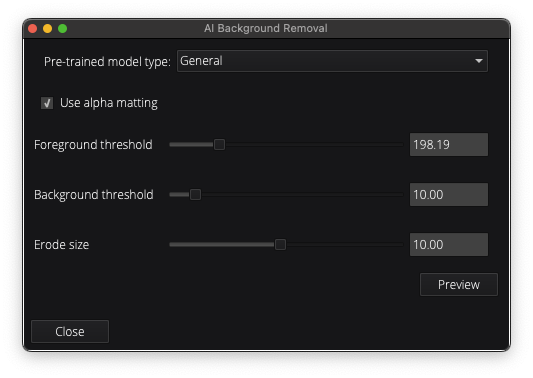Problem
When editing images and throughout Visere Captura, I'm getting confused about the difference of behavior of the buttons: OK, Apply, Reset, and Restore.
Abstract
Actions apply to the selected thumbnail image. Here is a brief description of each button:
- OK: Applies a filter to the image, closes the dialog box (if present), and resets the filter parameters to their default settings.
- Apply: Applies a filter to the image, keeps the dialog box open (if present), and does not reset the filter parameters.
- Reset: Resets the filter parameters to their default settings and adjusts the image display to best fit. It does not close the dialog box (if present).
- Restore: Reloads the original image as captured by the camera, undoing all edits.
- Preview: If a filter does not automatically apply a preview, then the filter will have a Preview button that can be clicked to preview the filter impact.
Filter results are automatically previewed, in most cases, but the filters are not applied to the thumbnail image until OK or Apply is pressed.
Perceived Unusual Behavior with Apply
For most filters, Visere Captura automatically previews the filter effect on the thumbnail image. For example, when adjusting the Brightness filter, the following occurs:
- The preview will show the impact of the Brightness filter, but the changes are not yet applied to the image.
- When the user clicks the Apply button, the brightness adjustment is applied to the image.
- Recall that clicking Apply applies the filter but leaves the filter parameters unchanged.
- Because the Brightness filter parameters remain the same, the preview (after Apply was pressed) will now show the brightness filter applied a second time.
While this might seem unusual, it is consistent with the intended functionality of the Apply button. To avoid this behavior, simply click the OK button instead of Apply.
Detailed Explanation
To make Visere Captura an efficient image editor, most imaging filters are automatically previewed as the filter parameters are adjusted. For filters that do not automatically preview, such as AIBR, a Preview button is provided to view the filter preview results:
The preview applies to the selected image only. Once the user presses OK or Apply, then the filter is applied to all the selected images.
From the main Visere Captura screen, select the images to edit and click the Edit tools button. The following screen will appear:
The editing tools are divided into three groups.
Background Removal Tools (Left Top)
These tools are the available background removal (BR) tools, listed from top to bottom:
1. Magic Wand tool.
2. Lasso tool.
3. Magnetic Lasso tool.
4. Reference Image BR tool: Uses a reference image of the background to remove backgrounds.
5. Dual Shot BR tool: Uses two separately exposed images to distinguish between background and foreground.
6. Chroma Key BR tool: Removes the background assuming it is green, red, or blue.
7. AI BR tool: Uses artificial intelligence to remove backgrounds.
Image Altering and Modification Tools (Top Center)
These tools are used for modifying the image, adjusting it, or creating new images. They include, from left to right:
- Focus Stacking. Used to take images taken at different focus lengths to create one sharp image.
- Watermark. This is used to generate a watermarking filter, which can be added at the output time, or at editing time.
- View Alignment. This tools is used to see the locus of multiple, same size, images to better understand how well a 360 is centered.
- Add Canvas. Add left, right, top, and bottom canvas.
- Rotate. Rotate the image.
- Resize. Resize the image.
- Transform. Allows you to shift the image from left to right, top to bottom, for alignment purposes, when trying to center a 360.
- Crop. Crops an image.
Basic Color Adjustment Tools (Right Bottom)
These tools contain the basic color adjust options and they are previewed sequentially:
- Select Levels or Curves. These are two standard methods for manipulating the histogram.
- Sharpness. Applies an unsharp masking.
- Brightness. Applies a histogram adjustment.
- Contrast. Histogram adjustment.
- Hue and Saturation.
- Temperature adjustment based on pixel selection.
- Tint adjustment.
OK, Apply, Reset, Restore, and Preview
With an understanding of all the available editing tools, here is how the OK, Apply, Reset, and Restore buttons work:
- Only one filter can be active at a time. If you select a new filter, the previous filter will close.
- Most filters are previewed automatically as you adjust their parameters. If a filter does not preview automatically, it will have a Preview button, as with AIBR.
- Previewing does not apply the filter to the image. The filter is only applied when you click OK or Apply.
- OK: Applies the filter to all selected images, closes the dialog box (if present), and resets the filter settings to their default values.
- Apply: Applies the filter to all selected images, keeps the dialog box open (if present), and retains the current filter settings.
- Reset: Restores the filter parameters and display to their default values without closing the dialog box (if present).
- Restore: Reverts all selected images to their original state as captured by the camera, undoing all edits.
- Preview: When a filter does not apply the filter parameter changes, usually because the filter takes a long time to process, then the filter provides a Preview button that allows you to preview the parameter changes, before applying them.
Additionally, each filter has a Profile option (listed to the right of the screen). Clicking the plus sign next to the profile saves the current filter settings to a file, which can be recalled later. This feature allows you to save a Watermark filter, for example, and recall it during batch or dynamic saving.


